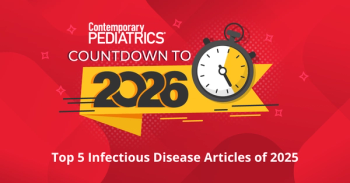
Top 10 Common Medication Errors-Drug #3: Ceftriaxone
Ceftriaxone is used to treat an array of infections and can be given once daily IV or IM. However, it should generally be avoided in neonates, especially those with high bilirubin levels. This case demonstrates how problems can -- and do -- occur with this agent.
Medication errors are relatively common.1 In this series, I focus on 10 errors commonly seen in the pediatric outpatient setting.2,3
A 22-day-old neonate (gestational age, 37 weeks; weight, 4 kg) with otitis media was seen by his pediatrician. On presentation, he was febrile and looked jaundice. His bilirubin level was slightly above the upper limit of normal.
The clinician prescribed 200 mg of ceftriaxone (50 mg/kg) IM x 1 for the otitis media. The 1-g ceftriaxone vial was mixed with 2.1 mL of 1% lidocaine to a final concentration of 350 mg/mL. The dose was drawn up and administered accordingly.
What’s the problem here?
Discussion
Ceftriaxone is a third-generation intravenous cephalosporin that is often used in the pediatric population for an array of infections ranging from pneumonia to otitis media. This antibiotic has the advantage of once-daily dosing, and it can be given intravenously or intramuscularly. This is especially beneficial in the outpatient setting: a single dose of ceftriaxone administered intramuscularly can be given to a pediatric patient who presents with a first episode of uncomplicated otitis media.
The problem, however, is that ceftriaxone should be generally avoided in neonates, especially those whose bilirubin level is elevated because ceftriaxone can displace bilirubin from its binding site.4 The free bilirubin can cross the blood-brain barrier and cause kernicterus, which can be deadly.
Another example of medication that should be avoided in neonates is oral ibuprofen. Medications that contain a high amount of sodium benzoate should also be avoided because benzoate can displace bilirubin from its binding site. High levels of benzoic acid (≥ 99 mg/kg/d) may also lead to gasping syndrome in neonates.4
Another problem in this case is that sterile water for injection (SWI) rather than 1% lidocaine should be used to reconstitute the ceftriaxone vial in patients younger than 3 months. Potential mistakes can occur in which too much lidocaine is erroneously given to young patients, leading to toxicity.
References
1. Kaushal R, Goldmann D, Keohane C, et al. Adverse drug events in pediatric outpatients. Ambul Pediatr. 2007;7:383-389.
2. So J.
3. So J. Top 10 common medication errors-and how to avoid them: Drug #2: insulin. Oct 18, 2012.
4. Taketomo CK, Hodding JH, Kraus DM. Pediatric Dosage Handbook. 18th ed. Hudson, Ohio: Lexi-Comp; 2011.
Newsletter
Access practical, evidence-based guidance to support better care for our youngest patients. Join our email list for the latest clinical updates.




